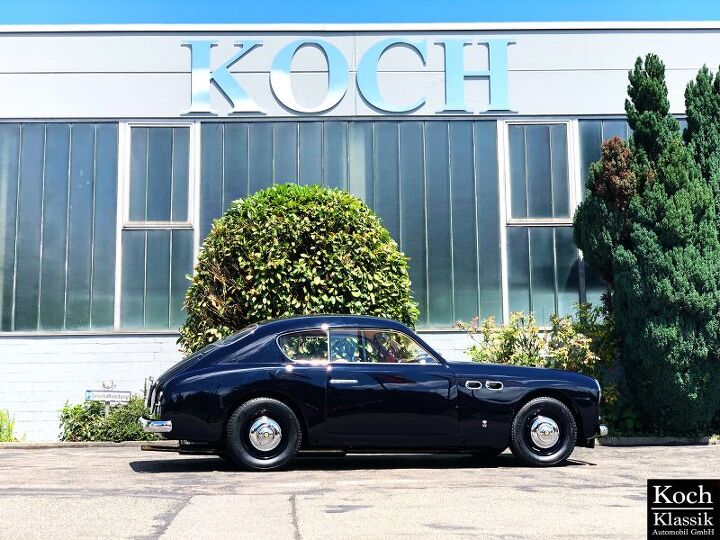Rare Rides: The 1952 Siata Daina - a Mysterious Coupe

Today’s Rare Ride is one of those cars where your author had heard of neither marque nor model before encountering a sale listing. A luxurious early Fifties coupe of Italian origin and simple, elegant coachwork, this Daina is one of six remaining worldwide.
The Siata name was an Italian acronym, which translated stood for Italian Car Transformation Accessories Company. Formed in 1926 by racing driver Giorgio Ambrosini, the company first produced performance parts for various Fiats. With a solid business foundation, Siata entered into complete automobile production after the conclusion of WWII.
Through its history Siata produced eight different models, all of which qualify as Rare Rides. Though Siata produced some beautiful cars, the company took a turn after the early Sixties. At that point it conducted market research focused on Italian youths. The youths responded that they wanted a roadster with corny, almost neoclassical styling. Thus Siata’s swan song, the Spring, was introduced in 1968. The single model offering sustained Siata only through 1970, when the company folded. Assets were sold to an organization called ORSA, which was promptly crushed by the oil crisis of 1973. Spring production ended in 1975, and Siata was gone for good. Let’s return to Daina.
Daina was the longest-lived model in Siata’s stable, entering production in 1950. Available in coupe or cabriolet guises, bodies were bespoke affairs designed by Stabilimenti Farina, Bertone, and other smaller Italian design firms. Underneath the Daina, Siata stuck to its core competency: It was a very heavy modification of the Fiat 1400, a common small family car that also debuted in 1950.
For a start, Siata chopped 10 inches from the Fiat’s wheelbase and strengthened the frame. It then borrowed three different engines from Fiat (of 1.4, 1.5, and 1.8 liters) and developed new valve heads, manifolds, carburetors, and borrowed the occasional exhaust system from well-known Fiat tuner Abarth. Transmissions were manual, and had either four or five speeds. Such details were all negotiable, depending on customer desires. The front suspension was independent, with a live axle at the rear. Brakes were drums at all corners.
Siata took the Daina racing, as was intended from the start. Cars participated in the Mille Miglia and the International Grand Prix. They also raced at Sebring, and in 1952, a 1.5-liter Daina Grand Sport placed first in its class, and third overall.
Daina production was incredibly slow. The model’s full run from 1950 to 1958 saw about 50 completed cars, most of which were built before 1953. Of the 50, the majority were of the Gran Sport (cabriolet) type, while only 20 Sports (coupes) were completed.
Our subject’s coupe body was sourced from Stabilimenti Farina, a coachwork firm founded by Giovanni Farina. Giovanni employed his younger brother Battista in the early days, who stuck with the car building thing when he founded Pininfarina in 1930. Pietro Frua worked there too. Important place!
Already fully restored, this sparkling navy blue Daina is one of six Sports remaining globally. It asks $187,800 in Germany.
[Images: seller]

Interested in lots of cars and their various historical contexts. Started writing articles for TTAC in late 2016, when my first posts were QOTDs. From there I started a few new series like Rare Rides, Buy/Drive/Burn, Abandoned History, and most recently Rare Rides Icons. Operating from a home base in Cincinnati, Ohio, a relative auto journalist dead zone. Many of my articles are prompted by something I'll see on social media that sparks my interest and causes me to research. Finding articles and information from the early days of the internet and beyond that covers the little details lost to time: trim packages, color and wheel choices, interior fabrics. Beyond those, I'm fascinated by automotive industry experiments, both failures and successes. Lately I've taken an interest in AI, and generating "what if" type images for car models long dead. Reincarnating a modern Toyota Paseo, Lincoln Mark IX, or Isuzu Trooper through a text prompt is fun. Fun to post them on Twitter too, and watch people overreact. To that end, the social media I use most is Twitter, @CoreyLewis86. I also contribute pieces for Forbes Wheels and Forbes Home.
More by Corey Lewis
Latest Car Reviews
Read moreLatest Product Reviews
Read moreRecent Comments
- Ltcmgm78 Just what we need to do: add more EVs that require a charging station! We own a Volt. We charge at home. We bought the Volt off-lease. We're retired and can do all our daily errands without burning any gasoline. For us this works, but we no longer have a work commute.
- Michael S6 Given the choice between the Hornet R/T and the Alfa, I'd pick an Uber.
- Michael S6 Nissan seems to be doing well at the low end of the market with their small cars and cuv. Competitiveness evaporates as you move up to larger size cars and suvs.
- Cprescott As long as they infest their products with CVT's, there is no reason to buy their products. Nissan's execution of CVT's is lackluster on a good day - not dependable and bad in experience of use. The brand has become like Mitsubishi - will sell to anyone with a pulse to get financed.
- Lorenzo I'd like to believe, I want to believe, having had good FoMoCo vehicles - my aunt's old 1956 Fairlane, 1963 Falcon, 1968 Montego - but if Jim Farley is saying it, I can't believe it. It's been said that he goes with whatever the last person he talked to suggested. That's not the kind of guy you want running a $180 billion dollar company.







































Comments
Join the conversation
I've heard of the Siata Spring and the Siata Sport, but not this.
looks very nice . -Nate